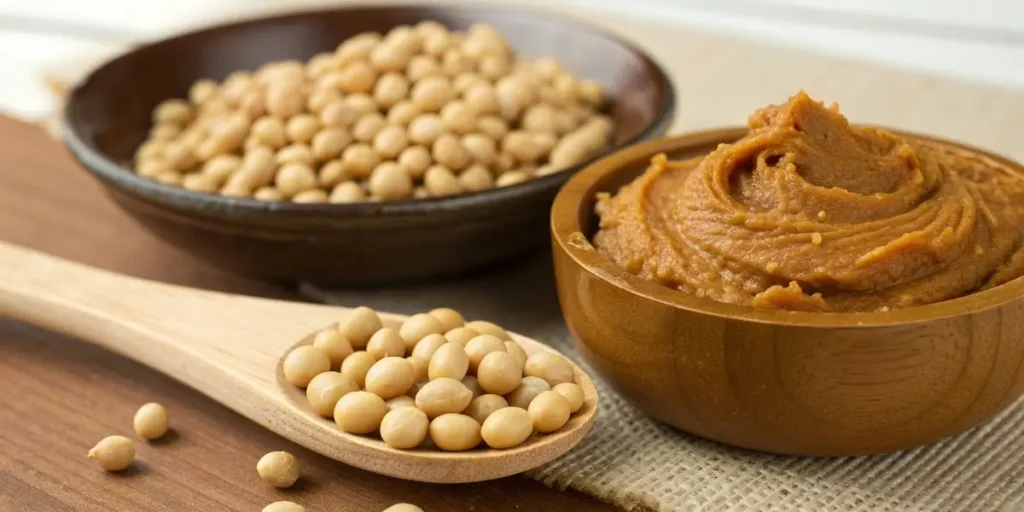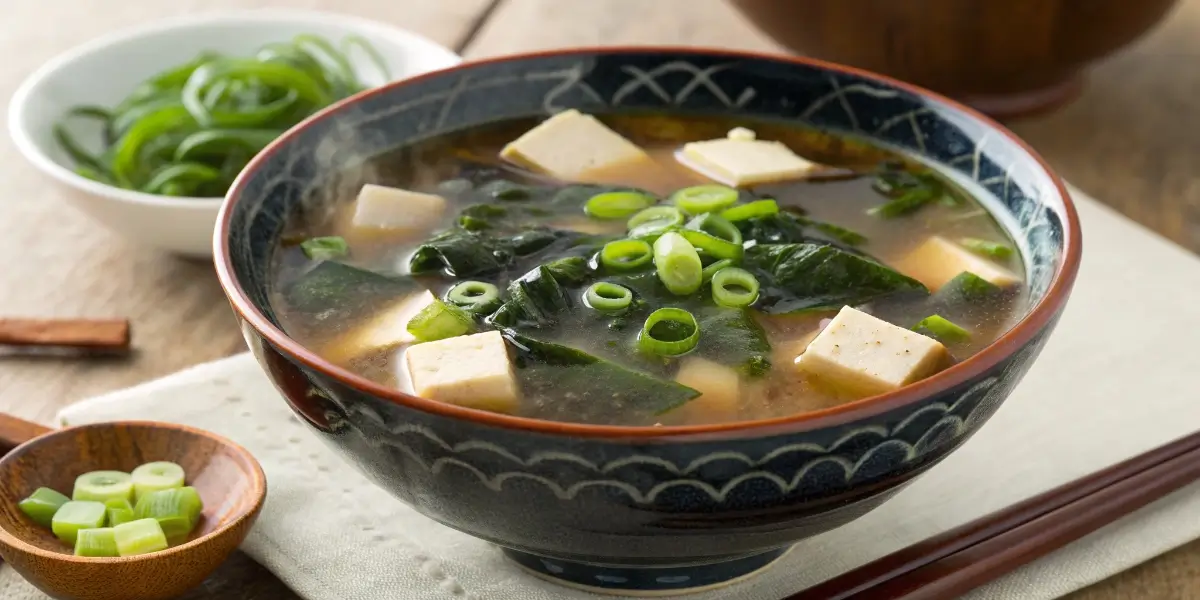Nutrition Info Miso Soup: Everything You Need to Know for a Healthy Choice
Miso soup is more than just a warm, comforting Japanese dish—it’s a nutritional powerhouse packed with protein, minerals, and beneficial probiotics. Whether you’re curious about its calorie count, wondering if it fits your diet, or comparing it to other healthy soups, this guide breaks down everything you need to know about nutrition info miso soup. We’ll look closely at its macronutrients, benefits for weight loss, and how it compares to other soup options. If you’re health-conscious or aiming to make smarter food choices, this deep dive will help you decide if miso soup deserves a spot in your regular meal plan.
Learn more about other flavorful Japanese-inspired dishes by visiting Japanese Mounjaro Recipe.
Table of Contents
Understanding the Nutrition Info Miso Soup
What is Miso Soup Made Of?
Miso soup is traditionally made with miso paste, dashi broth (a fish or seaweed-based stock), tofu, green onions, and sometimes wakame seaweed. The miso paste, created by fermenting soybeans with salt and koji (a type of mold), is what gives the soup its signature umami flavor and nutritional value.
Nutritional Breakdown of Miso Soup
Here’s a quick look at the nutrition info per 1 cup (about 240 ml) of traditional miso soup:
| Nutrient | Amount per Serving | % Daily Value* |
|---|---|---|
| Calories | 40–50 kcal | — |
| Protein | 2–3 g | 5% |
| Fat | 1–2 g | 2% |
| Carbohydrates | 5–6 g | 2% |
| Sugars | <1 g | — |
| Sodium | 600–900 mg | 30–40% |
| Fiber | 0.5 g | 2% |
| Probiotics | High (from fermentation) | — |
*Values vary depending on ingredients and preparation method.
Check out Tom Yum Recipe for another nutrient-packed soup option.
Key Nutrients and Health Benefits
Miso soup is rich in essential minerals like zinc, manganese, and copper. It’s also a great source of B vitamins, which help your body convert food into energy. The live cultures in fermented miso paste support gut health, potentially improving digestion and immunity.
Discover great ideas like Mirepoix Broth Concentrate if you’re interested in making nutrient-rich bases for soups and sauces.
How Miso Type Affects Nutrition
There are different types of miso—white (shiro), yellow, and red (aka).
- White miso: Lighter flavor, lower salt, slightly sweeter.
- Red miso: Longer fermentation, stronger taste, higher sodium, and more antioxidants.
- Mixed miso (awase): Combines both, offering balanced flavor and nutrition.
Don’t miss our Healthy Shredded Chicken recipe for another protein-rich meal idea that pairs well with miso soup.
Sodium Considerations and Low-Sodium Options
While miso soup is healthy, it can be high in sodium—especially restaurant versions. Opt for low-sodium miso paste or reduce added soy sauce to keep your salt intake balanced. Pairing it with potassium-rich sides like spinach salad can help counter sodium effects.
Looking for inspiration? Try our Low Sodium Chicken Recipes for more low-salt meal ideas.
Is Miso a Carb or Protein?
The Macronutrient Profile of Miso
Miso is primarily made from fermented soybeans, which makes it an excellent source of plant-based protein. However, because soybeans also contain natural carbohydrates, miso offers a balanced mix of both macronutrients. On average, one tablespoon of miso paste contains 2 grams of protein and 3 grams of carbohydrates, making it both a carb and protein food, but slightly higher in protein.

How Miso Protein Supports Your Diet
The proteins in miso are considered complete proteins, meaning they provide all nine essential amino acids your body needs for muscle repair and immune function. For vegans or vegetarians, miso is a smart way to increase protein intake without relying on animal products. Pairing miso soup with tofu or seaweed enhances the amino acid profile, creating a more filling, nutrient-dense meal.
Check out Edamame Spaghetti Recipe for another high-protein plant-based option that complements miso soup beautifully.
Understanding the Carbohydrates in Miso
Although miso contains carbs, these are mostly complex carbohydrates that digest slowly, providing a steady source of energy. Miso’s fermentation process also helps break down sugars, reducing the glycemic load. This means miso soup won’t cause sharp spikes in blood sugar, making it suitable for most balanced diets.
Learn more about balancing complex carbs with protein by exploring High Protein Overnight Oats.
Comparing Miso’s Protein to Other Plant-Based Foods
Here’s a simple table comparing miso’s protein content to other common plant-based ingredients:
| Food | Serving Size | Protein (g) | Carbohydrates (g) |
|---|---|---|---|
| Miso Paste | 1 tbsp | 2 | 3 |
| Tofu | ½ cup | 10 | 2 |
| Tempeh | ½ cup | 15 | 6 |
| Edamame | ½ cup | 8 | 9 |
| Chickpeas | ½ cup | 7 | 20 |
As you can see, miso offers modest protein but excels when used as a base for soups or marinades, adding both nutrition and depth of flavor.
Don’t miss our Vegan Yum Yum Sauce Recipe if you’re looking for more soy-based, high-protein flavor options.
How Miso Fits Into Different Diets
- Keto or Low-Carb Diets: Miso soup can fit into low-carb diets when prepared with fewer noodles and added fats like tofu or seaweed.
- Vegan Diets: 100% plant-based, miso is a staple ingredient for vegan-friendly soups and sauces.
- Gluten-Free Diets: Use certified gluten-free miso paste made without barley or wheat.
For more gluten-free inspiration, check out our Gluten-Free Chicken Noodle Soup, another soothing and nutritious meal option.
Does Miso Soup Have a Lot of Sugar?
The Truth About Sugar in Miso Soup
Despite its rich, savory taste, miso soup contains very little sugar. A typical cup of homemade miso soup has less than 1 gram of natural sugars, mainly from the soybeans used in miso paste. There are no added sugars unless sweeteners like mirin (a sweet rice wine) or certain vegetables are included in the recipe.
This makes miso soup an excellent choice for people who are watching their sugar intake or managing conditions like diabetes.
Comparing Sugar Levels in Popular Soups
Let’s see how miso soup stacks up against other common soups when it comes to sugar content:
| Soup Type | Average Sugar (per 1 cup) | Notes |
|---|---|---|
| Miso-Soup | <1 g | Naturally low in sugar |
| Tomato Soup | 12 g | Often contains added sugar |
| Chicken Noodle Soup | 2 g | Mildly sweet from carrots |
| Pumpkin Soup | 6 g | Natural sugars from pumpkin |
| Corn Chowder | 8 g | High in starch-based sugars |
It’s clear miso-soup leads the pack for being one of the lowest-sugar soups available.
Check out Delicious Hibachi Chicken for another low-sugar Japanese-inspired meal that balances protein and flavor.
Why Low-Sugar Foods Matter for Health
Consuming low-sugar meals like miso-soup can help reduce calorie intake, maintain stable energy levels, and lower the risk of insulin spikes. Miso’s fermented soybeans also add prebiotics and probiotics, which can support better blood sugar regulation.
Learn more about low-sugar desserts by exploring Sugar Free Ice Cream — a great option if you’re craving something sweet after your meal.
Hidden Sources of Sugar in Restaurant Miso Soup
While homemade miso soup is nearly sugar-free, restaurant versions sometimes add small amounts of mirin or sweetened soy sauce. If you’re dining out, ask whether the broth or miso paste contains added sugars. Opting for authentic Japanese or homemade recipes helps keep the nutrition info in miso soup clean and balanced.
Don’t miss our Gluten-Free Side Dishes for more healthy, sugar-conscious meal pairings.
Best Tips to Keep Miso Soup Low-Sugar at Home
- Choose unsweetened miso paste (check the ingredient label for sugar or mirin).
- Add natural flavor using ginger, garlic, or seaweed instead of sweeteners.
- Use fresh tofu and low-sodium dashi for depth of flavor without extra sugar.
For more balanced meal prep inspiration, discover our Healthy Suhoor Ideas — full of wholesome, low-sugar recipes to complement your diet.
Is Miso Soup Okay for Weight Loss?

How Miso Soup Supports a Weight-Loss Diet
If you’re aiming to shed extra pounds, miso soup can absolutely fit into your weight-loss plan. One of its biggest advantages is its low-calorie content — typically only 40 to 50 calories per cup. Despite being light, it’s full of flavor and nutrients that help keep you satisfied without adding unnecessary calories. The probiotics from fermented miso also support gut health, which is closely tied to metabolism and weight control.
Discover great ideas like Detox Island Green Smoothie to pair with your miso-soup for a cleansing, nutrient-rich meal combo.
The Role of Protein and Fiber in Miso Soup
While miso-soup is not high in fiber, it provides a modest amount of protein (2–3 grams per serving) that helps keep hunger at bay. Adding tofu, seaweed, or vegetables like bok choy and mushrooms can turn it into a more satisfying, low-calorie high-protein meal.
Looking for another light yet filling meal? Don’t miss our Vegan Breakfast Burrito Recipe.
The Thermogenic Benefits of Warm Soups
Warm soups like miso soup can have a thermogenic effect, meaning they slightly raise your body temperature, helping to boost metabolism. Eating hot broth-based dishes before a main course also encourages portion control since it fills your stomach and curbs overeating.
Learn more about metabolism-friendly meals in our Delicious Healthy Frozen Yogurt Treats.
Balancing Sodium While Losing Weight
One thing to watch out for is miso soup’s sodium content. A single serving can contain 600–900 mg of sodium, depending on the brand. To keep it weight-loss-friendly:
- Use low-sodium miso paste.
- Dilute your soup with more water or dashi stock.
- Add fresh greens or tofu for volume without salt.
Check out our Low Sodium Chicken Recipes to learn more ways to manage sodium without sacrificing taste.
How to Incorporate Miso Soup into a Weight-Loss Meal Plan
Here’s an example of how to enjoy miso-soup in a balanced, low-calorie daily plan:
| Meal | Example | Calories |
|---|---|---|
| Breakfast | Green smoothie + Miso-soup | 150 |
| Lunch | Grilled salmon + Steamed veggies + Miso-soup | 350 |
| Dinner | Tofu stir-fry + Brown rice + Miso-soup | 400 |
| Total | ~900 calories (before snacks) |
This approach makes miso-soup a low-calorie filler that adds nutrients, flavor, and satisfaction to every meal.
Is Miso Soup Actually Healthy?
The Nutritional Strengths of Miso Soup
Miso soup earns its reputation as one of Japan’s healthiest comfort foods. It’s packed with probiotics, essential minerals, and plant-based protein. Because it’s made from fermented soybeans, miso contains good bacteria like Lactobacillus, which help balance your gut microbiome and improve digestion.
Each cup of miso soup also delivers vital nutrients such as zinc, manganese, and copper, which play key roles in immune function, metabolism, and energy production. The fermentation process even enhances nutrient absorption, allowing your body to get more from the foods you eat alongside miso soup.
For another immune-boosting recipe, check out our Homemade Yogurt Fruit Dip.
Heart and Gut Health Benefits
The probiotics in miso soup help support both heart and digestive health. Regular consumption has been linked to reduced levels of “bad” LDL cholesterol, better blood pressure control, and improved gut regularity. Additionally, fermented soy products like miso may help lower inflammation throughout the body.
Discover more probiotic-rich ideas in our Kefir Chia Seed Pudding – A Healthy Treat.
Miso-Soup and Immune Function
Because miso is fermented, it contains active cultures that can strengthen the immune system. These beneficial bacteria interact with your intestinal cells, stimulating your body’s natural defenses. Miso also contains antioxidants that fight oxidative stress, which helps your body fend off infections.
Learn more about nutrient-dense soups in our 10 Vegetable Soup Recipe, another great option for supporting immune wellness.
Potential Downsides of Miso Soup
While miso-soup is healthy, moderation is key. The main concern is sodium—some store-bought or restaurant versions can contain nearly 1,000 mg per serving. If you’re monitoring your blood pressure or sodium intake, look for low-sodium miso paste and balance your diet with potassium-rich foods like avocados, bananas, and leafy greens.
Don’t miss our Greek Side Dishes to find nutrient-rich, heart-healthy pairings for your meals.
Miso Soup for Longevity and Everyday Wellness
Japanese communities that consume miso regularly—such as those in Okinawa—tend to have longer lifespans and lower rates of chronic diseases. Researchers attribute this to a diet rich in fermented foods, plant proteins, and antioxidants. Incorporating miso soup a few times a week can contribute to better digestion, stronger immunity, and overall wellness.
Which Soup Is Best for Fat Loss?
Why Soups Help with Fat Loss
Soups are among the most effective meal options for fat loss because they’re low in calories yet high in volume. Their high water content helps fill your stomach, reducing hunger and calorie intake without leaving you feeling deprived. When you choose nutrient-dense soups—like miso, vegetable, or bone broth-based ones—you nourish your body while promoting steady fat burn.
Check out our Cabbage Kielbasa Soup Recipe for a hearty, low-calorie soup rich in fiber and protein.
How Miso Soup Compares to Other Soups for Fat Loss
Let’s compare miso-soup’s fat-loss potential with other popular options:
| Soup Type | Calories per Cup | Protein | Fat | Notable Benefits |
|---|---|---|---|---|
| Miso Soup | 40–50 | 2–3 g | 1–2 g | Probiotic, low-calorie, boosts digestion |
| Chicken Broth | 15–20 | 1 g | 0 g | Hydrating, sodium-dependent |
| Vegetable Soup | 60–80 | 2 g | 1 g | High fiber, fills you up |
| Lentil Soup | 120–150 | 9 g | 2 g | Protein-packed, more filling |
| Bone Broth | 35–50 | 9 g | 0 g | Collagen support, gut healing |
Miso soup ranks near the top for low calories and high nutrient density, making it an excellent fat-loss companion when combined with other balanced meals.

Learn more about broth-based meals in our Instant Pot Vegetable Beef Soup.
Best Additions to Miso Soup for Fat Loss
Enhancing miso soup with lean proteins and fiber-rich vegetables can make it even more effective for fat loss. Try adding:
- Tofu: Boosts protein while staying low in calories.
- Seaweed: Provides iodine and minerals that aid metabolism.
- Spinach or kale: Adds fiber and volume.
- Ginger: Promotes thermogenesis and fat oxidation.
For a flavorful twist, don’t miss our Ginger Bug Recipe, a natural probiotic drink that supports gut and metabolic health.
Soups to Avoid for Weight or Fat Loss
Not all soups are created equal. Avoid creamy, high-fat versions like clam chowder or bisques—they can pack over 300 calories per cup. Soups with heavy cream, butter, or excessive starches can quickly sabotage your calorie goals.
To make smarter swaps, explore our Healthy Apple Crumble Recipe for a light, nutritious dessert to complement your fat-loss plan.
The Verdict: Miso Soup Tops the List
Among all soup options, miso soup stands out as one of the best for fat loss thanks to its low calorie count, probiotic content, and metabolism-friendly nutrients. It’s satisfying, cleansing, and versatile—perfect as a light starter or a full meal when enriched with veggies and protein.
Common Myths and Misconceptions About Miso Soup Nutrition
Myth 1: Miso Soup Is Too Salty to Be Healthy
Many believe miso soup is automatically unhealthy because of its sodium content. While it’s true that miso contains salt, the key lies in portion control and balance. One serving of miso soup has about 600–900 mg of sodium, but when paired with potassium-rich foods or balanced meals, it fits perfectly within a healthy diet. Choosing low-sodium miso paste can cut this amount nearly in half.
Don’t miss our Low Sodium Chicken Recipes for more practical ways to manage sodium intake while enjoying flavorful meals.
Myth 2: The Fermentation Process Makes It Unsafe
Some people think fermented foods like miso are risky to consume. In reality, fermentation is what makes miso soup so nutritious. The process increases beneficial probiotics and breaks down anti-nutrients, making minerals more bioavailable. When stored properly, miso paste is both safe and shelf-stable for months.
Check out Homemade Rhubarb Jam — another example of how fermentation or preservation can add nutrients and flavor safely.
Myth 3: Miso Soup Is Only for Japanese Cuisine
While miso soup originates from Japan, it’s become a global favorite because of its simple ingredients and health benefits. You can easily incorporate miso into Western-style dishes—think miso salad dressings, marinades, and even soups like chicken miso stew. Its versatility makes it a perfect addition to any healthy eating plan.
Discover great ideas like Garlic Parmesan Chicken Pasta to see how Asian flavors blend beautifully with global cuisines.
Myth 4: Miso Soup Isn’t Filling Enough
Though light in calories, miso-soup can be made heartier with ingredients like tofu, mushrooms, or whole grains such as brown rice. The umami flavor also helps reduce cravings, making it a satisfying low-calorie choice.
Learn more about making filling, protein-packed soups with our Panera Chicken Tortilla Soup recipe.
Myth 5: Packaged Miso Soups Are Just as Healthy
Instant miso soup packets can be convenient, but they’re often high in sodium and contain additives or preservatives. For maximum nutrition, go with fresh, refrigerated miso paste and homemade broth. This gives you full control over sodium, flavor, and quality.
Conclusion
Miso soup isn’t just a simple appetizer — it’s a nutrient-dense, gut-friendly, and low-calorie powerhouse that supports digestion, immunity, and weight management. With its unique blend of fermented soy, minerals, and probiotics, it brings warmth and wellness to any meal. Whether you’re counting calories, improving gut health, or simply looking for flavorful, wholesome comfort food, miso soup deserves a regular place in your diet.
Final Tip: Opt for homemade miso soup using low-sodium miso paste and fresh ingredients like tofu, wakame, and green onions for the most balanced nutrition. Pair it with other wholesome dishes like Healthy Shredded Chicken or Greek Lemon Rice Soup for a complete, nourishing meal.
FAQs
What is the nutritional value of miso soup?
A standard serving (1 cup) of miso soup contains approximately 40–50 calories, 2–3 grams of protein, and 5–6 grams of carbohydrates. It’s low in fat (around 1–2 grams) and rich in essential minerals like manganese, zinc, and copper. Miso soup also delivers beneficial probiotics that support gut health.
Is miso a carb or protein?
Miso contains both carbohydrates and protein, but it’s considered primarily a plant-based protein. Made from fermented soybeans, miso offers complete proteins with all nine essential amino acids, making it a great addition to vegetarian and vegan diets.
Does miso soup have a lot of sugar?
No — miso soup is naturally low in sugar, containing less than 1 gram per serving. Unless you add sweeteners like mirin or certain vegetables, it’s one of the most sugar-conscious soups available.
Is miso soup okay for weight loss?
Absolutely! Miso soup is low-calorie and rich in probiotics, making it a great addition to a weight-loss plan. It helps reduce bloating, supports digestion, and keeps you full longer. Add tofu, seaweed, or spinach for more protein and fiber.
Is miso soup actually healthy?
Yes, miso soup is one of the healthiest traditional soups. It promotes gut health, boosts immunity, and provides essential minerals. The key is to watch your sodium intake and use low-sodium miso paste if you’re on a heart-conscious diet.
Which soup is best for fat loss?
When it comes to fat loss, miso soup ranks near the top for being low-calorie and nutrient-rich. It provides filling umami flavor without added fats or sugars. Other excellent options include broth-based vegetable and lentil soups.

